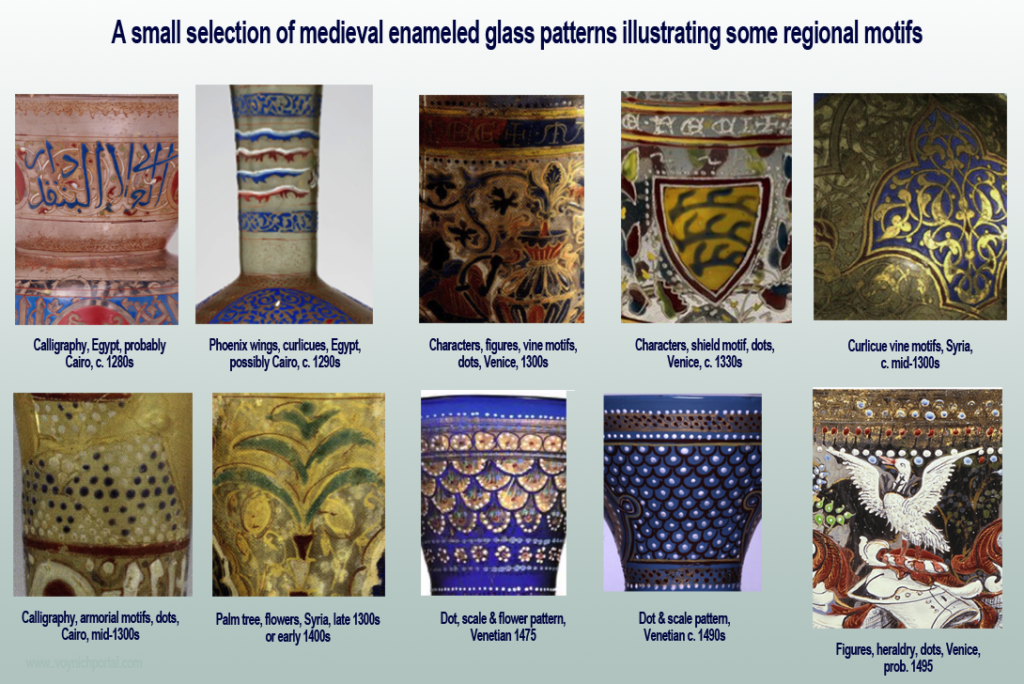The container on f89r of the Voynich manuscript has always struck me as an attempt to draw transparency. The bulbous part near the top (below the finial), and the narrow stem, seem to be encased in an outer layer. It would be difficult to create patterns like this out of crystalline stone, but fused glasses sometimes look like this.
http://dardogallettostudios.com/shall-we-tango-festival-gala-concert-milonga-midnight-show-with-misse-espinoza/ I don’t want to get too tied to the idea of glass, but if it is glass, could such a container be fabricated in the 15th century?
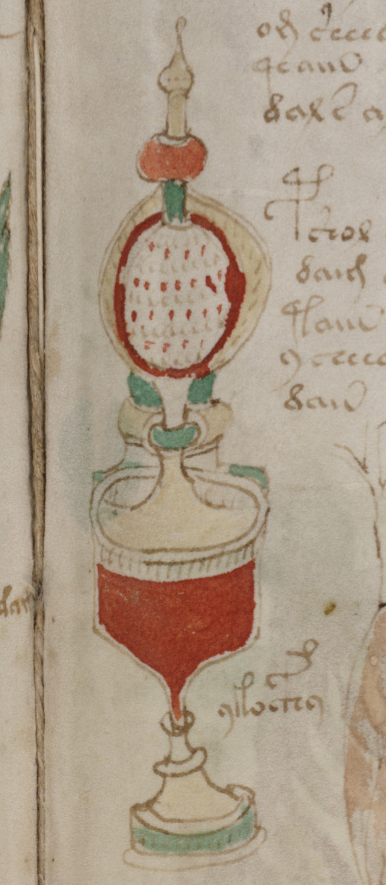
Antique Glass
I’m familiar with Murano glass and Bohemian glass in general, I have antique glass in my personal collection. I saw some exquisite etched glass while traveling through Hungary. Italian glass is well-known and has been actively traded through Venice for hundreds of years, but was glass technology sufficiently advanced in the 15th century to create vessels as fabulous as the one in the VMS?
I don’t have enough free time to research and answer this intriguing question, but I gathered a few pictures of amphoriska that demonstrate that glass-making in Greece, the Levant, and the Roman Empire, were quite sophisticated in earlier times. Most of the following artifacts were created 2,600 to 1,500 years ago.
We can see from the examples, that glassmakers knew how to create translucent, feathered glass in multiple colors approximately 2,500 years ago, and that iridescence and the use of sliced canes (the ancient equivalent of millefiori) had also been achieved by the Roman era. Molded and patterned surface textures (both added and intrinsic) were also part of the glassmaker’s repertoire (click to see larger):
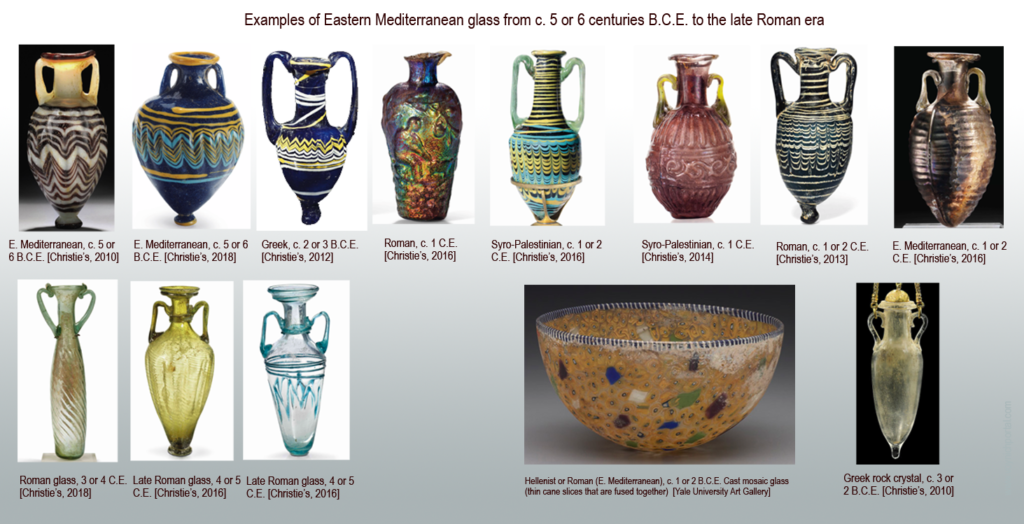
The detail in these little amphorae is extraordinary, considering they were only about 3″ high. Note that the detail in the carved rock crystal (bottom-right) was also remarkable—equal to that of many blown-glass vessels.
Signed pieces from the early Roman era also demonstrate a high level of skill in creating molded pieces, some of which compare favorably to glass housewares from the 1940s.
Layered Glass
But what about cased glass, one of the techniques that might result in a container similar to the VMS drawing? Cased glass is glass that is fused so one color shows through another (e.g., transparent glass over colored glass) and is sometimes cut to further reveal the underlying layer. It’s more difficult than fusing multiple colors within the same layer.
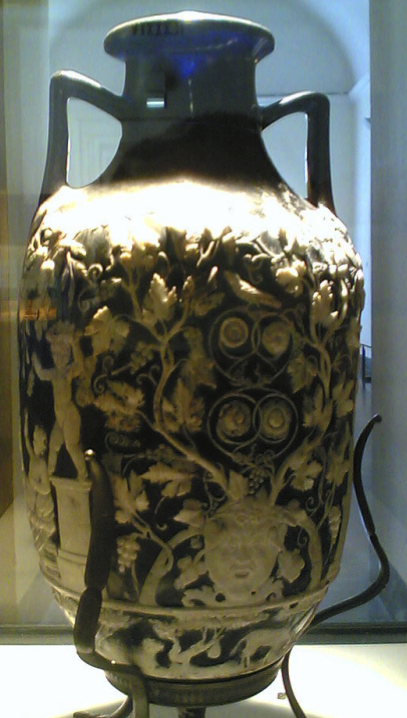
Bohemian glass from the last couple of centuries is well-known for this technique (Egermann and Moser pioneered some of the modern methods). Beads made from slices of caned glass (sometimes called “eye” glass) go back to the ancients but I was not able to find ancient artifacts that had a layer of translucent glass fused on top of colored glass in a curved vessel.
The closest I was able to find was “cameo glass” like the magnificent Blue Vase from Pompeii (right), held in the Naples museum (a museum that was “on strike” when I attempted to visit it years ago), but it does not have the same effect as cased glass in which translucent over colored is used instead of the other way around. Still, it does demonstrate the great level of sophistication achieved in ancient times. Some of these techniques disappeared for a few centuries during the Middle Ages.
Medieval Glass
Progress does not occur in a straight line and knowledge is sometimes lost. Millions died in famines, plagues, and wars, and their skills and trade secrets died with them. The techniques illustrated by the ancient amphoras can all be found in Europe in the 16th century, and a century later many new techniques were developed to reproduce ancient styles. But how much was known in the 15th and 14th centuries?
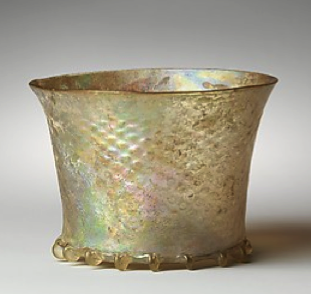
It was quite common for medieval glassmakers to add blobs of transparent or translucent glass as decorative additions. Engraved glass was not uncommon either. Glass enameling and a medieval form of “carnival” glass existed by the 15th century. Metal and glass were frequently combined, but it’s a struggle to find vessels in which a layer of translucent glass was fused on top of a colored layer.
If the VMS container is glass (or possibly glass with a metal base), it might not be cased glass. It might be translucent glass with an embedded pattern of colored glasses. The pattern does not look feathered, and appears too even and regular to be caned glass, so it is not an example of the most common styles, but if the vessel is partly imaginary, or a design for something that was not practical to fabricate, then the imagination of the illustrator may have embellished it.
Maybe it’s not glass at all. Maybe it’s one vessel behind another, or two different ideas for the same vessel. Or maybe it’s like a Russian doll, one vessel inside another, but drawn to show both.
I’m hoping that it’s at least partly glass, I like glass, but I’d better not hold my breath. VMS research has a way of stretching out longer than one expects.
J.K. Petersen
© Copyright 2019 J.K. Petersen, All Rights Reserved
Postscript Feb 22, 2019:
I didn’t post this image in the above article because it’s a rights-managed Getty image, and blog readers often don’t click on external links, but I wish I had because it illustrates similarities to the VMS containers that are strongly associated with the 15th century.
It’s a goblet made in Murano with a finial similar to the VMS container (which could be glass or metal). This kind of finial is not difficult to make in glass and is also common to Egyptian glass, so it’s not the primary reason I chose this example. What I suggest you pay attention to is the regular pattern of raised, applied enamel dots, a style and fabrication technique that was not typical of ancient glass:
Now hold that dot style in your mind and imagine it applied to a raised, translucent pattern, as in these Murano vessels (in the Museo del Vetro). Clear glass was a significant innovation of the early 1400s and from that point on was often combined with colored elements:
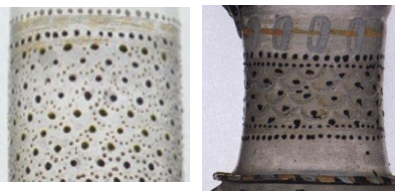
Scale motifs are found in almost all cultures, they are not exclusive to glass or to Murano, so I try not to get too excited when I see them, but every time I come across them, I am reminded of the many scaly patterns in various sections of the VMS.
Postscript Feb. 24, 2019:
I thought it might be helpful to include a few examples that illustrate regional differences in enameled glass motifs from about the late 1200s to the late 1400s:
